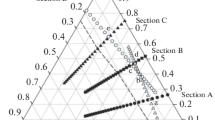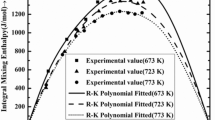Abstract
In the present study, Chou’s General Solution Model (GSM) has been used to predict the enthalpy and partial enthalpies of mixing of the liquid Ag–In–Sn ternary, Ag–In–Sn–Zn quaternary, and Ag–Au–In–Sn–Zn quinary systems. These are of technical importance to optimize lead-free solder alloys, in selected cross-sections: x In/x Sn = 0.5/0.5 (ternary), Au–In0.1–Sn0.8–Zn0.1, Ag–In0.1–Sn0.8–Zn0.1 (quaternary), and t = x Au/x In = 1, x In = x Sn = x Zn (quinary) at 1173, 773, and 773 K, respectively. Moreover, the activity of In content in the ternary alloy system Ag–In–Sn has been calculated and its result is compared with that determined from the experiment, while the activities of Ag contents associated with the alloys mentioned above have been calculated. The other traditional models such as of Colinet, Kohler, Muggianu, Toop, and Hillert are also included in calculations. Comparing those calculated from the proposed GSM with those determined from experimental measurements, it is seen that this model becomes considerably realistic in computerization for estimating thermodynamic properties in multicomponent systems.
Similar content being viewed by others
References
J. Glazer, “Metallurgy of low temperature Pb-free solders for electronic assembly,” Int. Mater. Rev. 40 (2), 65–93 (1995).
M. Abtew and G. Selvaduray, “Lead-free solders in microelectronics,” Mater. Sci. Eng. R 27, 95–141 (2000).
K. Suganuma, “Advances in lead-free electronics soldering,” Current Opinion in Solid State Mater. Sci. 5, 55–64 (2001).
J. Vizdal, M. H. Braga, A. Kroupa, K. W. Richter, D. Soares, L. F. Malheiros, and J. Ferreira, “Thermodynamic assessment of the Bi–Sn–Zn system,” Calphad 31, 438–448 (2007).
K. Suganuma, S.-J. Kim, and K.-S. Kim, “High-temperature lead-free solders: Properties and Possibilities,” JOM 61 (1), 64–71 (2009).
M. McCormack and S. Jin, “Lead-Free Solders,” J. Electron. Mater. 23, 635–640 (1994).
M. McCormack and S. Jin, “Improved mechanical properties in new lead-free solder alloys,” J. Electron. Mater. 23, 715–720 (1994).
T. Miki, N. Ogava, T. Nagasaka, and M. Hino, “Activity measurement of the constituents in molten Ag–In–Sn ternary alloy by mass spectrometry,” Mater. Trans. 42, 732–738 (2001).
X. J. Liu, Y. Inohana, Z. Takaku, I. Ohnuma, R. Kainuma, K. Ishida, Z. Moser, W. Gasior, and J. Pstrus, “Experimental determination and thermodynamic calculation of the phase equilibria and surface tension in the Sn–Ag–In system,” J. Electron. Mater. 31 1139–1151 (2002).
C. Luef, H. Flandorfer, and H. Ipser, “Lead-free solder materials: Experimental enthalpies of mixing of liquid Ag–In–Pd–Sn alloys,” Metall. Mater. Trans. A 36, 1273–1277 (2005).
W. Gierlotka, “Thermodynamic description of the quaternary Ag–Cu–In–Sn system,” J. Electron. Mater. 41, 86–108 (2012).
W. Oelsen and P. Zühlke, “Zur thermodynamischen Analyse VIII,” Arch. Eisenhüttenwes. 27, 743–754 (1956).
O. J. Kleppa, “Thermodynamic analysis of binary liquid alloys of group II B metals. I. The systems zinc–cadmium, zinc–gallium, zinc–indium and zinc–tin,” Acta Metall. 6, 225–232 (1958).
F. E. Wittig and E. Müller, “The heats of mixing of the binary liquid systems of zinc and cadmium with indium and thallium,” Z. Metallkd. 51, 226–238 (1960).
W. J. Svirbely and S. M. Selis, “A thermodynamic study of the zinc–indium system,” J. Am. Chem. Soc. 75, 1532–1535 (1953).
R. W. Bohl and V. D. Hildebrandt, “Electrode potential studies of liquid–solid equilibrium in Zn–Cd and Zn–In alloys,” J. Am. Chem. Soc. 79, 2711–2717 (1957).
Z. Moser, “Determination of the thermodynamic properties in Zn–In liquid solutions,” Rev. Rom. Chim. 16, 327–341 (1971).
O. J. Kleppa, “A thermodynamic study of liquid metallic solutions. VI. Calorimetric investigations of the systems bismuth–lead, cadmium–lead, cadmium–tin and tin–zinc,” J. Phys. Chem. 59, 354–361 (1955).
W. Oelsen, “Zur Kalorimetrie und Thermodynamik der Zinn–Zink-Legierungen,” Z. Metallkd. 48, 1–8 (1957).
E. Schürmann and H. Träger, “Die Empfindlichkeit und die Wiederholbarkeit von Messungen mit dem Kleinkalorimeter (The sensitivity and reproducibility of measurements with microcalorimeter),” Arch. Eisenhüttenwes. 32, 397–408 (1961).
Z. Moser, K. Rzyman, and S. Randzio, “Calorimetric studies on Zn–Sn liquid solutions,” Bull. Acad. Pol. Sci. Tech. 35, 461–464 (1987).
M. Genot and R. Hagege, “Etude thermodynamique du systeme etainzinc,” Compt. Rend. Acad. Sci. Fr. 25, 2901–2903 (1960).
Z. Qiao, X. Xing, and S. Duan, “A model for predicting ternary thermodynamic properties of solution phase and its appliciation,” J. Mater. Sci. Technol. 9, 199–204 (1993).
A. Boulouiz and A. Sabbar, “Pb-free solders: Experimental and calculated enthalpy of mixing of the liquid Au–In–Sn–Zn quaternary system,” Thermochim. Acta 575, 151–158 (2014).
M. Hillert, “Empirical methods of predicting and representing thermodynamic properties of ternary solution phases,” Calphad 4, 1–12 (1980).
F. Kohler, “Zur Berechnung der thermodynamischen Daten eines ternaren Systems aus dem zugehörigen binären Systemen,” Monatsh. Chem. 91, 738–740 (1960).
Y. M. Muggianu, M. Gambino, and J. P. Bros, “Enthalpies of formation of liquid alloys,” J. Chim. Phys. 72, 83–88 (1975).
G. W. Toop, “Predicting ternary activities using binary data,” Trans. AIME 233, 850–855 (1965).
K. C. Chou, “A general solution model for predicting ternary thermodynamic properties,” Calphad 19, 315–325 (1995).
C. Colinet, Ph. D. Thesis, Faculte des Sciences, Universite de Grenoble (1967).
J. Wang, P. Hudon, D. Kevorkov, P. Chartrand, In-Ho Jung, M. Medraj, “Thermodynamic and experimental study of the Mg–Sn–Ag–In quaternary system,” J. Phase Equilib. Diffus. 35, 284–313 (2014).
M. El. Maniani and A. Sabbar, “Partial and integral enthalpies of mixing in the liquid Ag–In–Sn–Zn quaternary alloys,” Thermochim. Acta 592, 1–9 (2014).
G. H. Zhang, L. J. Wang, and K. C. Chou, “A comparison of different geometrical models in calculating physicochemical properties of quaternary systems,” Calphad 34, 504–509 (2010).
K. C. Chou and S. K. Wei, “A new generation solution model for predicting thermodynamic properties of a multicomponent system from binaries,” Metal. Mater. Trans. B 28, 439–445 (1997).
H. Arslan, “Analytical determination of partial and integral properties of the six components systems Ni–Cr–Co–Al–Mo–Ti and their subsystems,” Physica B 438, 48–52 (2014).
H. Arslan, A. Dogan, and T. Dogan, “An analytical approach for thermodynamic properties of the sixcomponent systems Ni–Cr–Co–Al–Mo–Ti and its subsystems,” Phys. Met.Metallogr. 114, 1053–1060 (2013).
R. Tang, E. J. Qurelid, G. Tranell, and M. Tangstad, “Thermodynamic database for the solar cell silicon materials,” Mater. Trans. 50, 1978–1984 (2009).
S. Hassam, D. Boa, P. Benigni, and R. Rogez, “Critical assessment and optimization of the Ag–Au–Pb system,” Thermochim. Acta 510, 37–45 (2010).
H. Flandorfer, C. Luef, and U. Saeed, “On the temperature dependence of the enthalpies of mixing in liquid binary (Ag, Cu, Ni)–Sn alloys,” J. Non-Crystal. Solids 354, 2953–2972 (2008).
G.-T. Acebo, “Thermodynamic assessment of the Ag-Zn system,” Calphad 22, 203–220 (1988).
S. Hassam, D. Boa, and J. Rogez, “Calorimetric investigations of Au–In, In–Sb and Au–In–Sb systems at 973 K,” J. Alloys Compd. 520, 65–71 (2012).
S. Knott, Z. Li, and A. Mikula, “Integral enthalpy of mixing of the liquid ternary Au–Cu–Sn system,” Thermochim. Acta 470, 12–17 (2008).
R. Hultgren, P. D. Desai, D. T. Hawkins, M. Gleiser, and K. Kelly, The Selected Values of the Thermodynamic Properties of Binary Alloys (ASM, Metals Park, OH, 1973).
C. Luef, H. Flandorfer, and H. Ipser, “Enthalpies of mixing of liquid alloys in the In–Pd–Sn system and the limiting binary systems,” Thermochim. Acta 417, 47–57 (2004).
M. Rechchach, A. Sabbar, H. Flandorfer, and H. Ipser, “Enthalpies of mixing of liquid In–Sn, In–Sn–Zn alloys,” Thermochim. Acta 502, 66–72 (2010).
O. J. Kleppa, “Aspects of the thermodynamics of metallic solutions,” J. Phys. Rad. 23, 763–772 (1962).
Z. Guo, H. Hindler, W. Yuan, and A. Mikula, “Thermodynamic properties of liquid Au–Cu–Sn alloys determined from electromotive force measurements,” Thermochim. Acta 525, 183–189 (2011).
J. Wang, C. Leinenbach, and M. Roth, “Thermodynamic modeling of the Au–Ge–Sn ternary system,” J. Alloys Compd. 481, 830–836 (2009).
H. S. Liu, C. L. Liu, K. Ishida, and Z. P. Jin, “Thermodynamic modeling of the Au–In–Sn system,” J. Electron. Mater. 32, 1290–1296 (2003).
H. S. Liu, K. Ishida, K. Jin, and Y. Du, Thermodynamic assessment of the Au–Zn system,” Intermetallics 11, 987–994 (2003).
D. Jendrzejczyk and K. Fitzner, “Thermodynamic properties of liquid silver–indium alloys determined from EMF measurements,” Thermochim. Acta 433, 66–71 (2005).
E. Prezdziecka-Mycielska, J. Terpilowski, and K. Strozecka, “Thermodynamic properties of liquid metallic solutions. XI. The Ag–In system,” Arch. Hutnictwa 2, 85–101 (1963).
T. Nozaki, M. Shimoji, and K. Niwa, “Thermodynamic studies on liquid silver–indium alloys,” Trans. Jpn. Inst. Met. 7, 52–55 (1966).
C. B. Alcock, R. Sridhar, and R. C. Svedberg, “A mass spectrometric study of the binary liquid alloys Ag–In and Cu–Sn, Acta Metall. 17, 839–844 (1969).
G. J. Qi, H. Mitsuhisa, and A. Takeshi, “Thermodynamic study of liquid silver–indium and silver–gallium alloys with a Knudsen cell–mass spectrometer,” Mater. Trans. JIM 30, 575–582 (1989).
K. Kameda, Y. Yoshida, and S. Sakairi, “Activities of liquid silver–indium alloys by EMF measurements using zirconia solid and fused salt electrolytes,” Trans. Jpn. Inst. Met. 45, 614–620 (1981).
D. B. Masson and S. S. Pradhan, “Measurement of vapor pressure of indium over a Ag–In using atomic absorption,” Metall. Mater. Trans. A 4, 991–995 (1996).
B. J. Lee, C. S. Oh, and J. H. Shim, “Thermodynamic assessments of the Sn–In and SnBi binary systems,” J. Electron. Mater. 25, 983–991 (1973).
N. Moelans, K. C. Hari Kumar, and P. Wollants, “Thermodynamic optimization of the lead-free solder system Bi–In–Sn–Zn,” J. Alloy. Compd. 360, 98–106 (2003).
R. O. Frantik and H. J. McDonald, “Thermodynamic study of the tin–silver system,” Trans. Electrochem. Soc. 88, 253–262 (1945).
T. Nozaki, M. Shimoji, and K. Niwa, “Thermodynamic properties of Ag–Sn and Ag–Sb liquid alloys,” Ber. Bund. Gesellsch. 70, 207–241 (1966).
P. J. R. Chowdhury and A. Ghosh, “Thermodynamic measurements in liquid Sn–Ag alloys,” Metall. Trans. 2, 2171–2174 (1971).
K. Okajima and H. Sakao, “TIE measurements on the activities of the silver–antimony, silver–lead and silver–tin molten alloys,” Trans. JIM 15, 52–56 (1974).
M. Iwase, M. O. Yasuda, and S. I. Miki, “A thermodynamic study of liquid Ag–Sn alloys by means of solidoxide galvanic cell,” Trans. JIM 19, 654–660 (1978).
G. H. Laurie, A. H. Morris, and J. N. Pratt, “Electromotive force and calorimetric studies of thermodynamic properties of solid and liquid Ag–Sn alloys,” Trans. Metall. Soc. AIME 236, 1390–1395 (1966).
T. Yamaji and E. Kato, “Mass spectrometric study of the thermodynamic properties of the Ag–Sn system,” Metall. Mater. Trans. B 3, 1002–1004 (1972).
L. Bencze and A. Popovic, “Knudsen effusion mass spectrometric determination of mixing thermodynamic data of liquid Ag–In–Sn alloy,” Int. J. Mass. Spectrom. 270, 139–155 (2008).
D. Jendrzejczyk, W. Gierlotka, and K. Fitzner, “Thermodynamic properties of liquid copper–indium–tin alloys determined from EMF measurements,” J. Chem. Therm. 41, 250–256 (2009).
H. Arslan and A. Dogan, “An analytical investigation for thermodynamic properties of the Fe–Cr–Ni–Mg–O system,” Russ. J. Phys. Chem. A 89, 180–189 (2015).
T. Lauril, V. Vuorinen, and J. K. Kivialahti, “Interfacial reactions between lead-free solders and common base materials,” Mater. Sci. Eng., R: Reports 49, 1–60 (2005).
Y. T. Huang and T. H. Chuang, “Interfacial reactions between liquid In–49Sn solders and Ag substrates,” Z. Metallkd. 12, 1002–1005 (2000).
M. D. Cheng, S. S. Wang, and T. H. Chuang, “Soldering reactions between In49Sn and Ag thick films,” J. Electron. Mater. 31, 171–177 (2002).
I. I. Gorbachev and V. V. Popov, “Thermodynamic simulation of the Fe–V–Nb–C–N system using the CALPHAD method,” Phys. Met. Metallogr. 111, 495–502 (2011).
I. I. Gorbachev, V. V. Popov, and A. Yu. Pasynkov, “Thermodynamic simulation of the formation of carbonitrides in steels with Nb and Ti,” Phys. Met. Metallogr. 113, 687–695 (2012).
I. I. Gorbachev, V. V. Popov, and A. Yu. Pasynkov, “Thermodynamic modeling of carbonitride formation in steels with V and Ti,” Phys. Met. Metallogr. 113, 974–981 (2012).
Author information
Authors and Affiliations
Corresponding author
Additional information
The article is published in the original.
Rights and permissions
About this article
Cite this article
Dogan, A., Arslan, H. Composition dependences of thermodynamical properties associated with Pb-free ternary, quaternary, and quinary solder systems. Phys. Metals Metallogr. 117, 472–486 (2016). https://doi.org/10.1134/S0031918X16050045
Received:
Accepted:
Published:
Issue Date:
DOI: https://doi.org/10.1134/S0031918X16050045




